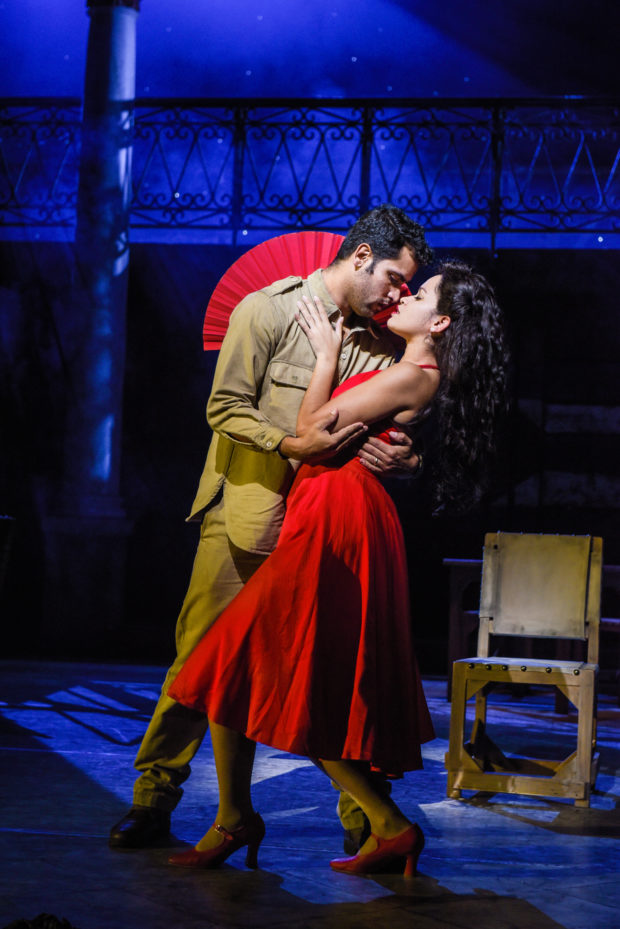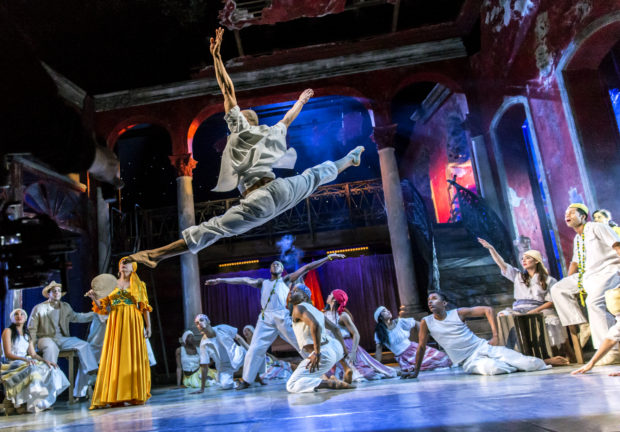You have no items in your cart. Want to get some nice things?
Go shoppingCarmen La Cubana deliberately disrupts the balance of classical opera by throwing Latin American dance into the picture. This disruption, however, among other novelties introduced by director Christopher Renshaw, proves an overall winning point.
Already turned into a successful Broadway musical (1943), a feature film (1954), and even a kathak-dancing production (2008), Bizet’s Carmen here becomes a Cuban heroine, and the year is 1958, in the midst of the Cuban Revolution. Keeping true to the “joyous and noisy” spirit of the people he found when visiting Cuba, Renshaw adds to Bizet’s arias the vibrant and effervescent rhythms of mambo, salsa, rumba and cha-cha-cha, arranged by Alex Licamoire.
The transposition to a Cuban setting brings with it a full translation of the libretto from French into Spanish by Norge Espinosa Mendoza. The result is startling, but compelling. On the one hand, staging Carmen in Spanish has the bold flavour of a work that deviates from the original. On the other hand, almost paradoxically, there is a sense of “bringing the opera home”.
I attended a classical production of Carmen a few years ago, and I still remember the slight sense of misplacement deriving from a Spanish setting (Bizet’s Carmen is set in 1820s Seville) acted in French. In Renshaw’s show, there is a virtual reunion between language and setting – an ultimately unifying factor rather than a disrupting one. It’s almost as if Carmen is made even more Carmen, in spite of being translated into a different language.

On top of this, the new libretto is not just a translation, but a bold adaptation to the new Cuban context. In the famous aria L’amour est un oiseau rebelle (“Love is a rebellious bird”), Mendoza’s love becomes a puñal (“dagger”). Shocking, but all things considered, in-keeping with the overall atmosphere of the production, which his imbued with a sense of uprising and fervour, passion and rebellion.
To the audience members with a basic grasp of the original opera and of Spanish, the production is though-provoking precisely in that it allows us to contemplate and ponder the choices made in the translation process. But to anyone, indistinctively, Carmen La Cubana offers a riveting story of love and revolution, whose setting most of the time feels as natural as if it had been the original one. The subtitles, if at times over-simplifying the words, provide an adequate explanation of the action – everyone is given the necessary tools to enjoy the performance.
Apart from the new setting, the second selling point of the production is dance. From Sadler’s Wells, I almost expected an all-dance performance, featuring collective dances, pas-à-deux, ballroom dance, and all possible variations in between. As the show progressed, I had to come to terms with the fact that Renshaw had gone for a more sparing usage of dance than anticipated: most of the show is actually either acted or sung (though, in both cases, brilliantly so).
My initial disappointment quickly turned into approval as the show proves a brilliant combination of the various elements of melodrama, with dance as an addition rather than a scene stealer. While not quite the star of the show, dance remains a valuable extra element, contributing to the production’s overall accomplishment. Needless to say, dance taps brilliantly into the vibrancy of the Cuban setting. It is arias (and dances) such as Las tabaqueras, Oye mi ritmo de tambor and El Gato Negro that remain the most memorable sections, with the ensemble of tireless dancers releasing palpable energy from the stage.

Balancing this dancing brilliance are the main characters of the all-Cuban cast as they sing and act, displaying a wide range of skills. Sexy and assertive Carmen (Luna Manzanares Nardo), the hilarious couple Paquita and Cuqui (Rachel Pastor Pérez and Laritza Pulido García), strong and pompous boxer El Niño (Joaquín García Mejías) are just some of the personalities we encounter on stage. There’s something to be said about Manzanares’ portrayal of Carmen, which embraces the role with impressively seductive and charismatic charm, once again bringing out Carmen’s very own soul by deviating from the original.
Explosive, sizzling, and with contagious moves, Carmen La Cubana is a mix of all things unchained. From the rhythms to the lead role, everything about this show speaks volumes of the energy of Cuba.
Carmen la Cubana will play until 18 August at Sadler’s Wells.
About Anna Zanetti
Anna graduated from the University of Oxford with a BA (Hons) in Classics, specialising in Literature, Aesthetics and Ancient Art. Currently based in London, she has eclectic interests, including avant-garde art, cycling, reading, contemporary dance, opera, (watching) rugby, and anything to do with Latin. She writes for The Oxford Culture Review, Theatre Bubble and A Younger Theatre, as well as keeping a personal blog about arts and culture.
- Web |
- More Posts(10)





One comment